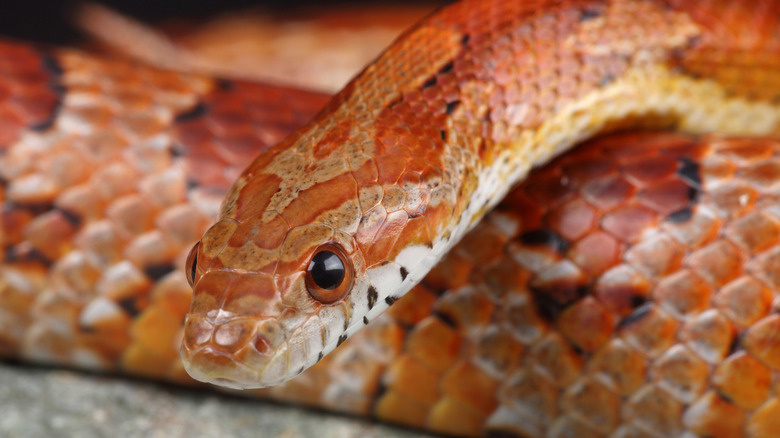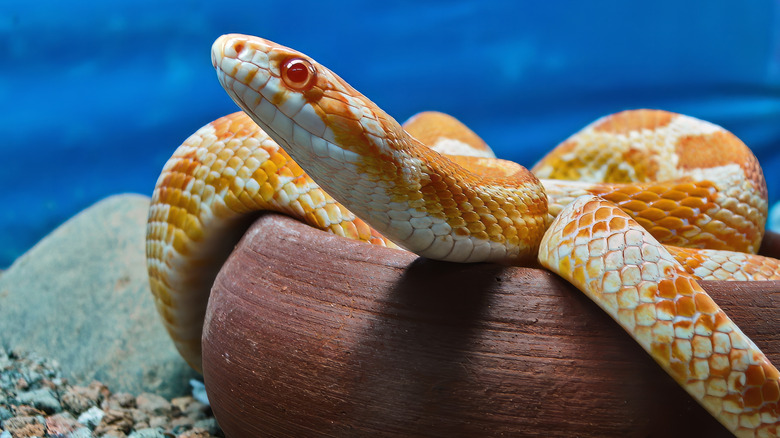How Often Should You Feed A Corn Snake? Less Than You Might Think
We may receive a commission on purchases made from links.
While many homes welcome cats or dogs, others opt for a pet that is considered more unconventional: snakes. Those who have accepted the scaly friends into their home often tout various reasons why snakes make great pets — from their calm nature, low maintenance, long lifespans beyond cats and dogs, unique bonding experience, and variety of species and patterns. For many snake enthusiasts, their first introduction comes from the corn snake, which is considered an excellent starter for its size and ease of care, particularly regarding feeding.
How much to feed a corn snake depends on its age and size; in captivity, it can live to be 23 or older and grows between 2 to 6 feet in length. In conversation with Reptifiles, professional reptile husbandry researcher and consultant Mariah Healey outlined how the amount to feed a corn snake varies by age and size. Hatchlings, which can range from 8 to 20 inches, should be fed every 5 to 7 days to coincide with their quick growth; juveniles, which range from 20 to 45 inches, can then be fed every seven to 10 days; and the 'sub-adult' phase, where it is between 35 to 50 inches, requires feeding every 10 to 12 days.
Once a snake matures and reach its full length, feeding should occur 14 to 21 days apart. However, there is some nuance with adult snakes as adjustments will be made for overweight adults, opting for meals every 21 to 45 days, and underweight corn snakes needing more frequent feeding every 10 to 14 days until back at a healthy weight. A senior corn snake over 18 years old also requires a more regular meal plan, eating every 10 to 14 days. There can be many nuances to feeding a pet snake, and adapting along with your snake and seeking professional advice or veterinarian input can ensure proper feeding times and amounts.
What to feed a corn snake
Like other snake breeds, a corn snake will thrive on a diet of primarily mice or rats. It is recommended to avoid live feed, as a struggling animal could potentially hurt a pet snake. Instead, mice or rats should be purchased frozen, thawed a day or two prior, and brought to room temperature an hour or two before feeding. The size of its meal factors in raising a healthy corn snake. To figure this out, any food given should be 1 to 1.5 the width of the corn snake at the broadest part of the body, ignoring the head.
In some cases, a corn snake may need to take two smaller portions of food that should not exceed 10% of the snake's body weight. For a juvenile corn snake, the diet should start with small 'pinkies' (hairless mice) before moving to 'fuzzies,' or slightly larger mice. MiceDirect offers various sizes, including a Combo Pack of Small Pinkies specifically for a growing corn snake and a Combo Pack of 20 Small Fuzzies to allow the proper size of feed throughout a snake's life cycle.
Snakes are carnivores, so adhering to an established diet and avoiding human food like vegetables, fruits, grains, and processed foods is essential. Quail eggs can be given as a treat, but it is best to stick to regular feed that meets its nutritional requirements. While feeding can be a bonding time for pet parents of cats and dogs, it is not the same case for snakes. Finding a routine and feeding the proper amount can help ensure a happy pet. A happy snake has a way of sssssssslithering straight into the hearts of its owner; treat it well, and the relationship can be rewarding one that lasts decades.
Always consult your veterinarian before making changes to your pet's diet, exercise, or care. To find an accredited veterinarian in your area, you can search the American Animal Hospital Association's online database.

